Numerical Blow-Up Time for a Semilinear Parabolic Equation with Nonlinear Boundary Conditions
Abstract
We obtain some conditions under which the positive solution for semidiscretizations of the semilinear equation ut = uxx − a(x, t)f(u), 0 < x < 1, t ∈ (0, T), with boundary conditions ux(0, t) = 0, ux(1, t) = b(t)g(u(1, t)), blows up in a finite time and estimate its semidiscrete blow-up time. We also establish the convergence of the semidiscrete blow-up time and obtain some results about numerical blow-up rate and set. Finally, we get an analogous result taking a discrete form of the above problem and give some computational results to illustrate some points of our analysis.
1. Introduction
In this last case, we say that the solution u blows up in a finite time and the time T is called the blow-up time of the solution u.
In good number of physical devices, the boundary conditions play a primordial role in the progress of the studied processes. It is the case of the problem described in (1.1) which can be viewed as a heat conduction problem where u stands for the temperature, and the heat sources are prescribed on the boundaries. At the boundary x = 0, the heat source has a constant flux whereas at the boundary x = 1, the heat source has a nonlinear radition haw. Intensification of the heat source at the boundary x = 1 is provided by the function b. The function g also gives a dominant strength of the heat source at the boundary x = 1.
The theoretical study of blow-up of solutions for semilinear parabolic equations with nonlinear boundary conditions has been the subject of investigations of many authors (see [1–7], and the references cited therein).
The authors have proved that under some assumptions, the solution of (1.1) blows up in a finite time and the blow-up time is estimated. It is also proved that under some conditions, the blow-up occurs at the point 1. In this paper, we are interested in the numerical study. We give some assumptions under which the solution of a semidiscrete form of (1.1) blows up in a finite time and estimate its semidiscrete blow-up time. We also show that the semidiscrete blow-up time converges to the theoretical one when the mesh size goes to zero. An analogous study has been also done for a discrete scheme. For the semidiscrete scheme, some results about numerical blow-up rate and set have been also given. A similar study has been undertaken in [8, 9] where the authors have considered semilinear heat equations with Dirichlet boundary conditions. In the same way in [10] the numerical extinction has been studied using some discrete and semidiscrete schemes (a solution u extincts in a finite time if it reaches the value zero in a finite time). Concerning the numerical study with nonlinear boundary conditions, some particular cases of the above problem have been treated by several authors (see [11–15]). Generally, the authors have considered the problem (1.1) in the case where a(x, t) = 0 and b(t) = 1. For instance in [15], the above problem has been considered in the case where a(x, t) = 0 and b(t) = 1. In [16], the authors have considered the problem (1.1) in the case where a(x, t) = λ > 0, b(t) = 1, f(u) = up, g(u) = uq. They have shown that the solution of a semidiscrete form of (1.1) blows up in a finite time and they have localized the blow-up set. One may also find in [17–22] similar studies concerning other parabolic problems.
The paper is organized as follows. In the next section, we present a semidiscrete scheme of (1.1). In Section 3, we give some properties concerning our semidiscrete scheme. In Section 4, under some conditions, we prove that the solution of the semidiscrete form of (1.1) blows up in a finite time and estimate its semidiscrete blow-up time. In Section 5, we study the convergence of the semidiscrete blow-up time. In Section 6, we give some results on the numerical blow-up rate and Section 7 is consecrated to the study of the numerical blow-up set. In Section 8, we study a particular discrete form of (1.1). Finally, in the last section, taking some discrete forms of (1.1), we give some numerical experiments.
2. The Semidiscrete problem
3. Properties of the Semidiscrete Scheme
In this section, we give some lemmas which will be used later.
The following lemma is a semidiscrete form of the maximum principle.
Lemma 3.1. Let ah(t) ∈ C0([0, T), ℝI+1) and let Vh(t) ∈ C1([0, T), ℝI+1) such that
Proof. Let T0 < T and define the vector Zh(t) = eλtVh(t) where λ is large enough that ai(t) − λ > 0 for t ∈ [0, T0], 0 ≤ i ≤ I. Let . Since for i ∈ {0, …, I}, Zi(t) is a continuous function, there exists t0 ∈ [0, T0] such that for a certain i0 ∈ {0, …, I}. It is not hard to see that
Another form of the maximum principle for semidiscrete equations is the following comparison lemma.
Lemma 3.2. Let Vh(t),Uh(t) ∈ C1([0, T), ℝI+1) and f ∈ C0(ℝ × ℝ, ℝ) such that for t ∈ (0, T)
Proof. Define the vector Zh(t) = Uh(t) − Vh(t). Let t0 be the first t ∈ (0, T) such that Zi(t) > 0 for t ∈ [0, t0), 0 ≤ i ≤ I, but for a certain i0 ∈ {0, …, I}. We observe that
4. Semidiscrete Blow-Up Solutions
In this section under some assumptions, we show that the solution Uh of (2.1)–(2.3) blows up in a finite time and estimate its semidiscrete blow-up time.
Before starting, we need the following two lemmas. The first lemma gives a property of the operator δ2 and the second one reveals a property of the semidiscrete solution.
Lemma 4.1. Let Uh ∈ ℝI+1 be such that Uh ≥ 0. Then we have
Proof. Apply Taylor′s expansion to obtain
Proof. Let t0 be the first t > 0 such that Ui+1(t) > Ui(t) for 0 ≤ i ≤ I − 1 but for a certain i0 ∈ {0, …, I − 1}. Without loss of generality, we may suppose that i0 is the smallest integer which satisfies the equality. Introduce the functions Zi(t) = Ui+1(t) − Ui(t) for 0 ≤ i ≤ I − 1. We get
The above lemma says that the semidiscrete solution is increasing in space. This property will be used later to show that the semidiscrete solution attains its minimum at the last node xI.
Now, we are in a position to state the main result of this section.
Theorem 4.3. Let Uh be the solution of (2.1)–(2.3). Suppose that there exists a positive integer A such that
Proof. Since is the maximal time interval on which ∥Uh(t)∥∞ < ∞, our aim is to show that is finite and satisfies the above inequality. Introduce the vector Jh such that
Remark 4.4. The inequality (4.19) implies that
Remark 4.5. If g(s) = sq, then G(s) = s1−q/(q − 1) and H(s) = ((q − 1)s) 1/(1−q).
5. Convergence of the Semidiscrete Blow-Up Time
In this section, we show the convergence of the semidiscrete blow-up time. Now we will show that for each fixed time interval [0, T] where u is defined, the solution Uh(t) of (2.1)–(2.3) approximates u, when the mesh parameter h goes to zero.
Theorem 5.1. Assume that (1.1) has a solution u ∈ C4,1([0, 1]×[0, T]) and the initial condition at (2.3) satisfies
Proof. Let α > 0 be such that
Now, we are in a position to prove the main result of this section.
Theorem 5.2. Suppose that the problem (1.1) has a solution u which blows up in a finite time Tb such that u ∈ C4,1([0, 1]×[0, Tb)) and the initial condition at (2.3) satisfies
Proof. Let ε > 0. There exists a positive constant N such that
6. Numerical Blow-Up Rate
In this section, we determine the blow-up rate of the solution Uh of (2.1)–(2.3) in the case where b(t) = 1. Our result is the following.
Theorem 6.1. Let Uh(t) be the solution of (2.1)–(2.3). Under the assumptions of Theorem 4.3, Uh(t) blows up in a finite time and there exist two positive constants C1, C2 such that
Proof. From Theorem 4.3 and Remark 4.4, Uh(t) blows up in a finite time and there exists a constant C2 > 0 such that
7. Numerical Blow-Up Set
In this section, we determine the numerical blow-up set of the semidiscrete solution. This is stated in the theorem below.
Theorem 7.1. Suppose that there exists a positive constant C0 such that sF′(s) ≤ C0 and
Proof. Let v(x) = 1 − x2 and define
8. Full Discretization
Let us notice that the restriction on the time step ensures the nonnegativity of the discrete solution. The lemma below shows that the discrete solution is increasing in space.
Proof. Let , 0 ≤ i ≤ I − 1. We observe that
The following lemma is a discrete form of the maximum principle.
Lemma 8.2. Let be a bounded vector and let a sequence such that
Proof. If then a routine computation yields
A direct consequence of the above result is the following comparison lemma. Its proof is straightforward.
Lemma 8.3. Suppose that and two vectors such that is bounded. Let and two sequences such that
Now, let us give a property of the operator δt.
Lemma 8.4. Let U(n) ∈ ℝ be such that U(n) ≥ 0 for n ≥ 0. Then we have
Proof. From Taylor′s expansion, we find that
To handle the phenomenon of blow-up for discrete equations, we need the following definition.
Definition 8.5. We say that the solution of (8.2)–(8.4) blows up in a finite time if
The following theorem reveals that the discrete solution of (8.2)–(8.4) blows up in a finite time under some hypotheses.
Theorem 8.6. Let be the solution of (8.2)–(8.4). Suppose that there exists a constant A ∈ (0, 1] such that the initial data at (8.4) satisfies
Proof. Introduce the vector defined as follows
Remark 8.7. Apply Taylor′s expansion to obtain , which implies that
In the sequel, we take τ = h2.
9. Convergence of the Blow-Up Time
In this section, under some conditions, we show that the discrete solution blows up in a finite time and its numerical blow-up time goes to the real one when the mesh size goes to zero. To start, let us prove a result about the convergence of our scheme.
Theorem 9.1. Suppose that the problem (1.1) has a solution u ∈ C4,2([0, 1]×[0, T]). Assume that the initial data at (8.4) satisfies
Proof. For each h, the problem (8.2)–(8.4) has a solution . Let N ≤ J be the greatest value of n such that
Now, we are in a position to state the main theorem of this section.
Theorem 9.2. Suppose that the problem (1.1) has a solution u which blows up in a finite time T0 and u ∈ C4,2([0, 1]×[0, T0)). Assume that the initial data at (2.3) satisfies
Proof. We know from Remark 8.7 that is bounded. Letting ε > 0, there exists a constant R > 0 such that
10. Numerical Experiments
Definition 10.1. We say that the discrete solution of the explicit scheme or the implicit scheme blows up in a finite time if and the series converges. The quantity is called the numerical blow-up time of the solution .
| I | Tn | n | CPU time | s |
|---|---|---|---|---|
| 16 | 0.047927 | 451 | — | — |
| 32 | 0.044695 | 1260 | 0.5 | — |
| 64 | 0.043583 | 4075 | 5 | 1.54 |
| 128 | 0.043225 | 14555 | 60 | 1.64 |
| 256 | 0.043115 | 55061 | 1816 | 1.71 |
| I | Tn | n | CPU time | s |
|---|---|---|---|---|
| 16 | 0.047631 | 423 | — | — |
| 32 | 0.044645 | 1234 | 1 | — |
| 64 | 0.043576 | 4050 | 5 | 1.49 |
| 128 | 0.043224 | 14533 | 99 | 1.61 |
| 256 | 0.043113 | 55035 | 2000 | 1.67 |
| I | Tn | n | CPU time | s |
|---|---|---|---|---|
| 16 | 0.018286 | 21750 | 3 | — |
| 32 | 0.017181 | 83838 | 17 | — |
| 64 | 0.016729 | 329960 | 108 | 1.30 |
| 128 | 0.016412 | 1298750 | 1570 | 0.51 |
| 256 | 0.016324 | 6447649 | 27049 | 1.85 |
| I | Tn | n | CPU time | s |
|---|---|---|---|---|
| 16 | 0.018283 | 21741 | 6 | — |
| 32 | 0.017181 | 83831 | 37 | — |
| 64 | 0.016729 | 3299953 | 347 | 1.30 |
| 128 | 0.016617 | 1208495 | 4640 | 2.01 |
| 256 | 0.016526 | 6348765 | 29957 | 0.30 |
| I | Tn | n | CPU time | s |
|---|---|---|---|---|
| 16 | 0.024197 | 1649 | — | — |
| 32 | 0.022570 | 6103 | 2 | — |
| 64 | 0.021950 | 23583 | 8 | 1.40 |
| 128 | 0.021734 | 92985 | 200 | 1.52 |
| 256 | 0.021712 | 369250 | 3243 | 3.30 |
| I | Tn | n | CPU time | s |
|---|---|---|---|---|
| 16 | 0.024169 | 1602 | — | — |
| 32 | 0.022566 | 6066 | 5 | — |
| 64 | 0.021950 | 23551 | 65 | 1.38 |
| 128 | 0.021734 | 92985 | 1140 | 1.52 |
| 256 | 0.021713 | 370240 | 6709 | 3.37 |
| I | Tn | n | CPU time | s |
|---|---|---|---|---|
| 16 | 0.054342 | 422 | — | — |
| 32 | 0.050346 | 1130 | — | — |
| 64 | 0.049027 | 3539 | 4 | 1.60 |
| 128 | 0.048615 | 12020 | 28 | 1.68 |
| 256 | 0.048491 | 46439 | 937 | 1.74 |
| I | Tn | n | CPU time | s |
|---|---|---|---|---|
| 16 | 0.054158 | 364 | — | — |
| 32 | 0.050332 | 1077 | 0.6 | — |
| 64 | 0.049030 | 3491 | 7 | 1.56 |
| 128 | 0.048616 | 12358 | 79 | 1.66 |
| 256 | 0.048519 | 36919 | 1123 | 2.10 |
Case 1. p = 0, q = 2, φi = 10 + 10 * cos (πih), λ = 1.
Case 2. p = 2, q = 4, φi = 10 + 10 * cos (πih), λ = 1.
Case 3. p = 2, q = 3, φi = 10 + 10 * cos (πih), λ = 1.
Case 4. p = 2, q = 2, φi = 10 + 10 * cos (πih), λ = 1.
Remark 10.2. The different cases of our numerical results show that there is a relationship between the flow on the boundary and the absorption in the interior of the domain. Indeed, when there is not an absorption on the interior of the domain, we see that the blow-up time is slightly equal to 0.043 for q = 2 whereas if there is an absorption in the interior of the domain, we observe that the blow-up time is slightly equal to 0.048 for q = 2 and p = 2. We see that there is a diminution of the blow-up time. We also remark that if the power of flow on the boundary increases then the blow-up time diminishes. Thus the flow on the boundary make blow-up occurs whereas the absorption in the interior of domain prevents the blow-up. This phenomenon is well known in a theoretical point of view.
For other illustrations, in what follows, we give some plots to illustrate our analysis. In Figures 1, 2, 3, 4, 5, and 6, we can appreciate that the discrete solution blows up in a finite time at the last node.
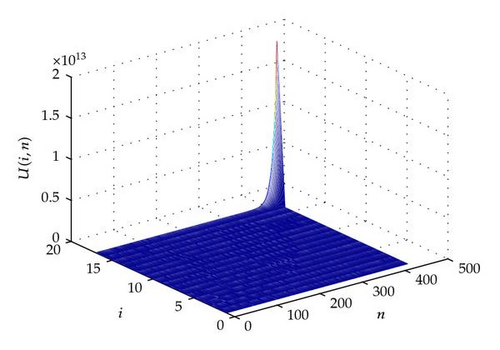
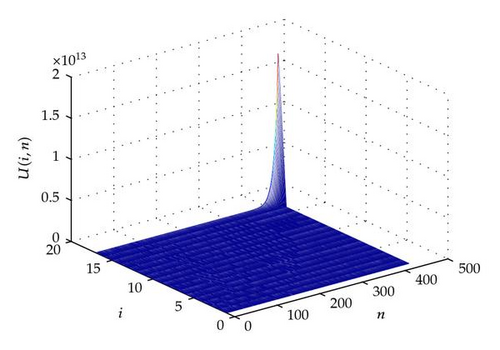
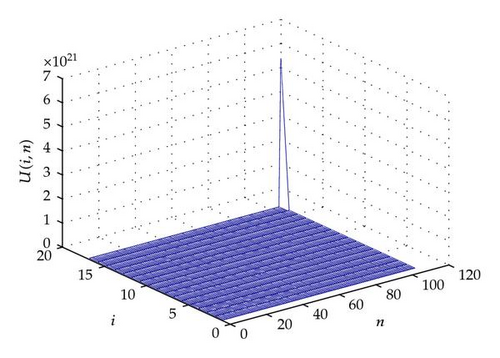
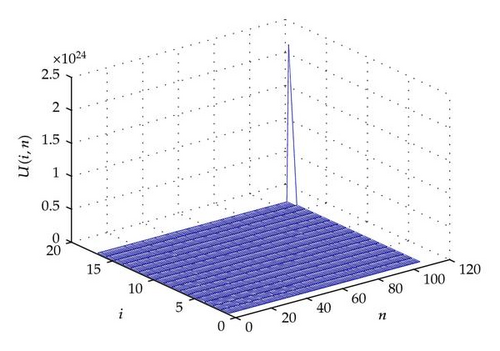
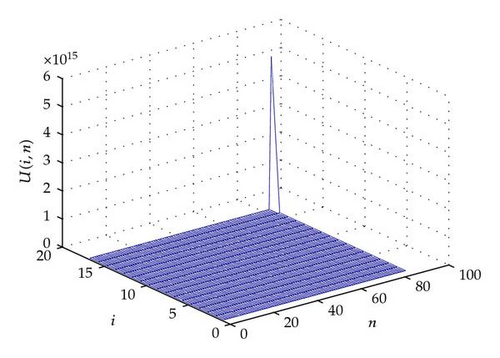
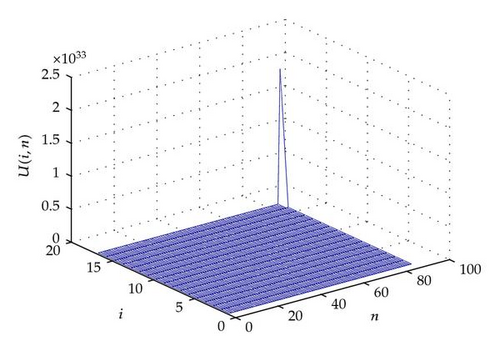
Acknowledgments
We want to thank the anonymous referee for the throughout reading of the manuscript and several suggestions that help us to improve the presentation of the paper.




